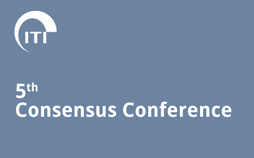
Therapy of Peri-Implantitis
Consensus Statements
The focused question for the review by Heitz-Mayfield and Mombelli was: In patients with osseointegrated implants diagnosed with peri-implantitis, how successful is treatment aimed at resolution of the disease?
Currently, there is no standard of care for treating peri-implantitis. Various clinical protocols for treating peri-implantitis have been proposed, including mechanical debridement, the use of antiseptics and local and systemic antibiotics, as well as surgical and regenerative procedures.
In view of the lack of comparable randomized controlled trials (RCTs) this review has taken a broader approach to capture as many relevant studies as possible, including randomized and observational studies, but with consideration to the strengths and limitations of the included research.
The ideal goal of the treatment of peri-implantitis would be the resolution of disease, ie, no suppuration or bleeding on probing, no further bone loss, and the re-establishment and maintenance of healthy periimplant tissues.
A composite outcome to reflect this would include absence of peri-implant PD ≥ 5 mm with concomitant bleeding on probing and no suppuration, in addition to no further bone loss.
If these criteria are met, it can be assumed that no further intervention other than nonsurgical maintenance care would be required, and the treatment outcome would therefore be regarded as successful. Unfortunately these data were rarely reported in the literature and therefore a compromise composite criterion for successful treatment outcome was employed, ie, implant survival with mean PD < 5 mm and no further bone loss. Although there is no consensus in the literature on whether a 5-mm peri-implant PD alone represents health or disease, this threshold was adopted for the purposes of the review.
This review was based on 33 studies reported in 43 papers including case-series of at least 5 patients treated with the same protocol and comparative studies. No studies were found comparing surgical and nonsurgical protocols. Based on this literature, the following conclusions were drawn:
- Interpretation of the results of studies is complicated by unclear or high risk of bias, heterogeneity of study design, and difficulty of generalizing outcomes to practice settings due to frequent exclusion of patients who smoke, those with poorly controlled diabetes, and other conditions that may affect clinical outcomes.
- There are no data investigating patient-reported outcomes and economic analysis of therapy.
- Peri-implantitis therapy was associated with softtissue recession, which was most evident following surgical treatment. Postsurgery complications including membrane exposure and infection were also reported.
Treatment Guidelines
As peri-implantitis is an infection associated with the presence of a submucosal bacterial biofilm around implants, the primary goal of therapy must be the resolution of the infection, which is achieved by the disruption of the biofilm, the removal of calculus and/or overhanging restoration margins, and the prevention of recurrence of the disease.
It is important to try to establish if iatrogenic or other factors have contributed to the infection, for example, ill-fitting or noncleansable overcontoured prostheses, malpositioned implants, or foreign bodies such as impression material or excess luting cement. Noniatrogenic factors may include impacted dental floss.
The following sequence of treatment of peri-implantitis is normally recommended:
Treatment Guidelines
Downloads and References
Related items
Share this page
Download the QR code with a link to this page and use it in your presentations or share it on social media.
Download QR code
